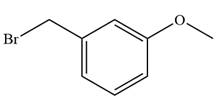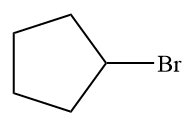
Concept explainers
(a)
Interpretation:
The complete mechanism that proceeds when the given species treated with triphenylphosphine followed by butyllithium is to be drawn.
Concept introduction:
The Wittig reagents can be generated from
Answer to Problem 17.53P
The complete mechanism of the given alkyl halide is treated with triphenylphosphine followed by butyllithium as shown below.

Explanation of Solution
The given alkyl halide is

The Wittig reagent is generated from the given alkyl halide and triphenylphosphine followed by butyllithium. Triphenylphosphine,

Lastly, the product obtained from the first step is treated with butyllithium to form Wittig reagent.

The complete mechanism of the given alkyl halide is treated with triphenylphosphine followed by butyllithium as shown below.

The complete mechanism for the given species treated with triphenylphosphine followed by butyllithium is drawn.
(b)
Interpretation:
The complete mechanism that proceeds when the given species treated with triphenylphosphine followed by butyllithium is to be drawn.
Concept introduction:
The Wittig reagents can be generated from alkyl halides. The alkyl halide is first reacted with triphenylphosphine and the product of that reaction is treated with a strong base. In the first step reaction fovors
Answer to Problem 17.53P
The complete mechanism of the given alkyl halide is treated with triphenylphosphine followed by butyllithium as shown below.

Explanation of Solution
The given alkyl halide is

The Wittig reagent is generated from the given alkyl halide and triphenylphosphine followed by butyllithium. Triphenylphosphine,

Lastly, the product obtained from the first step is treated with butyllithium to form Wittig reagent.

The complete mechanism of the given alkyl halide is treated with triphenylphosphine followed by butyllithium as shown below.

The complete mechanism for the given species treated with triphenylphosphine followed by butyllithium is drawn.
(c)
Interpretation:
The complete mechanism that proceeds when the given species treated with triphenylphosphine followed by butyllithium is to be drawn.
Concept introduction:
The Wittig reagents can be generated from alkyl halides. The alkyl halide is first reacted with triphenylphosphine and the product of that reaction is treated with a strong base. In the first step reaction fovors
Answer to Problem 17.53P
The complete mechanism of the given alkyl halide is treated with triphenylphosphine followed by butyllithium as shown below.

Explanation of Solution
The given alkyl halide is

The Wittig reagent is generated from the given alkyl halide and triphenylphosphine followed by butyllithium. Triphenylphosphine,

After that, the product obtained from the first step is treated with butyllithium to form Wittig reagent.

The complete mechanism of the given alkyl halide is treated with triphenylphosphine followed by butyllithium as shown below.

The complete mechanism for the given species treated with triphenylphosphine followed by butyllithium is drawn.
Want to see more full solutions like this?
Chapter 17 Solutions
EBK GET READY FOR ORGANIC CHEMISTRY
- Hi, I need your help with the drawing, please. I have attached the question along with my lab instructions. Please use the reaction from the lab only, as we are not allowed to use outside sources. Thank you!arrow_forwardHi, I need your help i dont know which one to draw please. I’ve attached the question along with my lab instructions. Please use the reaction from the lab only, as we are not allowed to use outside sources. Thank you!arrow_forward5. Write the formation reaction of the following complex compounds from the following reactants: 6. AgNO₃ + K₂CrO₂ + NH₄OH → 7. HgNO₃ + excess KI → 8. Al(NO₃)₃ + excess NaOH →arrow_forward
- Indicate whether the product formed in the reaction exhibits tautomerism. If so, draw the structure of the tautomers. CO₂C2H5 + CH3-NH-NH,arrow_forwardDraw the major product of this reaction N-(cyclohex-1-en-1-yl)-1-(pyrrolidino) reacts with CH2=CHCHO, heat, H3O+arrow_forwardDraw the starting material that would be needed to make this product through an intramolecular Dieckmann reactionarrow_forward
- Draw the major product of this reaction. Nitropropane reacts + pent-3-en-2-one reacts with NaOCH2CH3, CH3CHOHarrow_forwardIndicate whether the product formed in the reaction exhibits tautomerism. If so, draw the structure of the tautomers. OC2H5 + CoHs-NH-NH,arrow_forwardExplain how substitutions at the 5-position of barbituric acid increase the compound's lipophilicity.arrow_forward
- Explain how substitutions at the 5-position of phenobarbital increase the compound's lipophilicity.arrow_forwardName an interesting derivative of barbituric acid, describing its structure.arrow_forwardBriefly describe the synthesis mechanism of barbituric acid from the condensation of urea with a β-diketone.arrow_forward
 Organic Chemistry: A Guided InquiryChemistryISBN:9780618974122Author:Andrei StraumanisPublisher:Cengage Learning
Organic Chemistry: A Guided InquiryChemistryISBN:9780618974122Author:Andrei StraumanisPublisher:Cengage Learning
